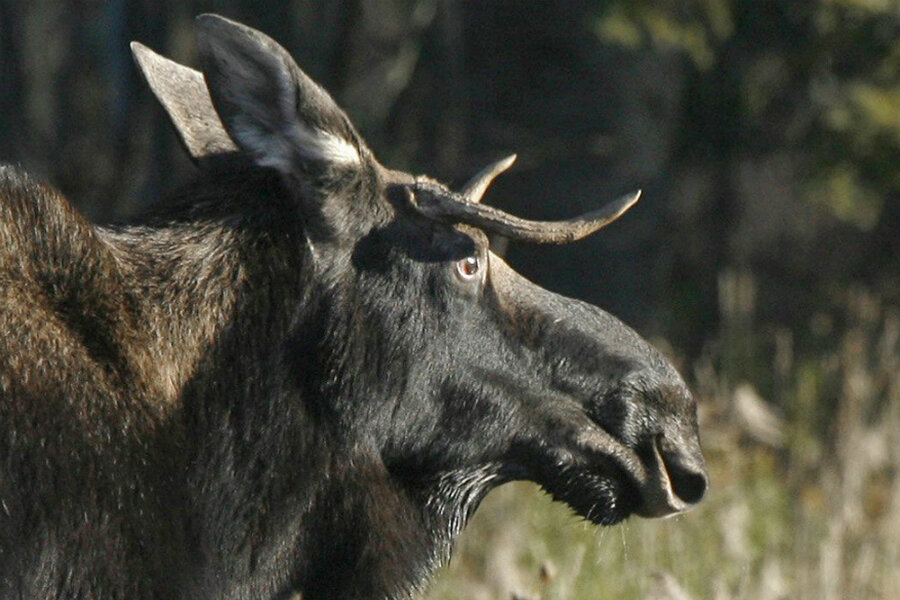What might Vermont learn from its multi-year moose study?
Loading...
Vermont will become the latest state to try to better understand its moose population, as herd numbers continue to drop off across the continental United States.
Starting this month, the Vermont Fish and Wildlife Department will place radio collars on up to 60 wild moose in an effort to determine their cause of death. Biologists particularly want to know if calves are surviving to adulthood.
Moose are a lynchpin of a healthy ecosystem, managing shrubbery for rabbits and birds and serving as food for predators. But the largest antlered animal in the world is dying off at an alarming rate across the continent. The studies Vermont and its neighbors are embarking on represent a joint effort to get a handle on declining moose populations in order to support them.
In Vermont, biologists will monitor the collared moose in a study that will be in effect until 2019. The state will monitor moose movements, deaths, and reproduction.
The study comes as Vermont’s moose herd has fallen off since the early 2000s. After reaching a high of more than 5,000, the Vermont herd stands at roughly 2,200 today, according to the Associated Press. The decrease is the result of a deliberate move on the part of the state to reduce its herd through hunting.
But moose in nearby New Hampshire, New York, and Maine are dying off from a combination of environmental stresses. In New Hampshire, the moose population has fallen by almost half in a decade to about 4,000, according to the Concord Monitor. In Maine, which has the largest moose population in the continental US, the population fell from about 75,000 in 2012 to an estimated 60,000 to 70,000 in 2015.
In the Northeast, an increasing number of winter tick parasites have been blamed for the death of moose. Up to 75,000 ticks have been known to leach onto one moose, resulting in blood loss, anemia, and disease for the large animals.
Herds in Minnesota, Montana, and Wyoming experienced similar drop-offs this decade, leading researchers to wonder what exactly is killing the moose, as Elizabeth Barber reported for The Christian Science Monitor in 2013:
Some scientists have pinned the die-off on climate-change related stress. As the forests get warmer, moose must expend more effort to keep themselves cool. This puts stress on the animal, leaving it vulnerable to disease, theorize some scientists.
But the cause could also be ticks, or flourishing wolves, or a worm that attacks the moose’s spinal cord and brain. Or it could be some complex combination these factors. Or it could be some other climate-change related alternation in the moose’s ecosystem or habitat – one, perhaps, that no one has yet identified. Factors not related to climate change, like over-hunting, could also be involved.
Not all moose populations in North America are hurting, however. In Alaska, researchers recently theorized that warming temperatures in the 20th century have contributed to moose moving into the Arctic regions of the state. Researchers say that’s because warmer temperatures led to larger shrubs, which both provide food and protect the massive animal, according to a paper published in April. The paper built on an existing theory that less hunting contributed to an increased moose population.
But that doesn't necessarily translate into good news. Animals moving northward encounter and affect new neighbors. Indeed, 2,000 species are shifting their ranges north at a rate of more than 10.5 miles each decade, as the Monitor’s Eva Botkin-Kowacki reported.
"You may see a reduction in diversity of vegetation due to the browsing pressures of these animals," Peter Pekins, a wildlife ecologist at the University of New Hampshire, told the Monitor at the time. As the new residents snack on the shrubs, they'll be competing with the other browsing species that were already there.
But Northeastern moose have proven themselves to be hardy animals in even more Southern states, populating regions that have perplexed some biologists because the areas are considered too warm for the moose. Beginning in the 1980s, a breeding herd began to reestablish itself in Massachusetts after 19th century-farming led to its disappearance there.
"The Northeastern US has been given a second chance," David Foster, the director of Harvard Forest in Petersham, Mass., told the Monitor in 2007.
This report contains material from the Associated Press.







